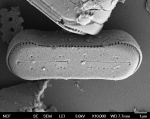
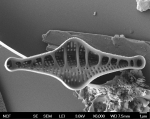
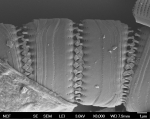

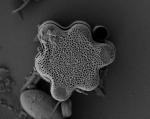
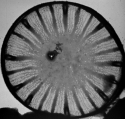
DiatomBase
HABs taxon details
Pseudo-nitzschia obtusa (Hasle) Hasle & Lundholm, 2005
531455 (urn:lsid:marinespecies.org:taxname:531455)
accepted
Species
marine, terrestrial
recent only
(of ) Hasle, G.R. (1974). Validation of the names of some marine planktonic species of Nitzschia (Bacillariophyceae). Taxon, 23(2/3): 425-428
page(s): p. 427 [details]
(of ) Hasle, G.R. (1965). Nitzschia and Fragilariopsis species studied in the light and electron microscope. II. The group Pseudonitzschia. Skrifter utgitt av Det Norske Videnskaps-Akademi i Oslo, Matematisk-naturvidenskapelig klasse, Ny Ser.,, 18: 45 pp., 17 pls
page(s): p. 10; pl. 3, fig. 8, 9, 11, pl. 4, fig. 5-7 [details]
page(s): p. 427 [details]
(of ) Hasle, G.R. (1965). Nitzschia and Fragilariopsis species studied in the light and electron microscope. II. The group Pseudonitzschia. Skrifter utgitt av Det Norske Videnskaps-Akademi i Oslo, Matematisk-naturvidenskapelig klasse, Ny Ser.,, 18: 45 pp., 17 pls
page(s): p. 10; pl. 3, fig. 8, 9, 11, pl. 4, fig. 5-7 [details]
Distribution A cold-water species, so far restricted to the Northern hemisphere
Harmful effect The species has been shown to produce domoic acid (0.167-0.332 pg per cell) in cultures from Greenland. The production was...
Identification requires electron microscopy.
The main characteristics of P. obtusa are the asymmetric valve and the 2 rows of poroids. P....
Distribution A cold-water species, so far restricted to the Northern hemisphere [details]
Harmful effect The species has been shown to produce domoic acid (0.167-0.332 pg per cell) in cultures from Greenland. The production was...
Harmful effect The species has been shown to produce domoic acid (0.167-0.332 pg per cell) in cultures from Greenland. The production was triggered when exposed to grazing copepods, (Hardardottir et al. 2015) [details]
Identification requires electron microscopy.
The main characteristics of P. obtusa are the asymmetric valve and the 2 rows of poroids. P....
Identification requires electron microscopy.
The main characteristics of P. obtusa are the asymmetric valve and the 2 rows of poroids. P. obtusa is phylogenetically and morphologically closely related to P. seriata and P. australis, two other species with asymmetric valves. The main differences are the number of poroid rows in the striae, poroid density, and valve width.
P. obtusa: 2 rows - 6-8 poroids/µm - 2.9-5.0µm
P. seriata:: (2)-4 rows - 6-9 poroids/µm - 4.6-8.0µm
P. australis:: 2 rows - 4-5 poroids/µm - 6.5-8.0µm
Verified sequences of ITS rDNA (ITS1, 5.8S, ITS2) are:
P. obtusa (DQ062667); P. seriata (DQ062663); P. australis (DQ062661) [details]
The main characteristics of P. obtusa are the asymmetric valve and the 2 rows of poroids. P. obtusa is phylogenetically and morphologically closely related to P. seriata and P. australis, two other species with asymmetric valves. The main differences are the number of poroid rows in the striae, poroid density, and valve width.
P. obtusa: 2 rows - 6-8 poroids/µm - 2.9-5.0µm
P. seriata:: (2)-4 rows - 6-9 poroids/µm - 4.6-8.0µm
P. australis:: 2 rows - 4-5 poroids/µm - 6.5-8.0µm
Verified sequences of ITS rDNA (ITS1, 5.8S, ITS2) are:
P. obtusa (DQ062667); P. seriata (DQ062663); P. australis (DQ062661) [details]
Kociolek, J.P.; Blanco, S.; Coste, M.; Ector, L.; Liu, Y.; Karthick, B.; Kulikovskiy, M.; Lundholm, N.; Ludwig, T.; Potapova, M.; Rimet, F.; Sabbe, K.; Sala, S.; Sar, E.; Taylor, J.; Van de Vijver, B.; Wetzel, C.E.; Williams, D.M.; Witkowski, A.; Witkowski, J. (2024). DiatomBase. Pseudo-nitzschia obtusa (Hasle) Hasle & Lundholm, 2005. Accessed through: Lundholm, N.; Churro, C.; Escalera, L.; Fraga, S.; Hoppenrath, M.; Iwataki, M.; Larsen, J.; Mertens, K.; Moestrup, Ø.; Murray, S.; Tillmann, U.; Zingone, A. (Eds) (2009 onwards) IOC-UNESCO Taxonomic Reference List of Harmful Micro Algae at: https://www.marinespecies.org/hab/aphia.php?p=taxdetails&id=531455 on 2024-05-01
Lundholm, N.; Churro, C.; Escalera, L.; Fraga, S.; Hoppenrath, M.; Iwataki, M.; Larsen, J.; Mertens, K.; Moestrup, Ø.; Murray, S.; Tillmann, U.; Zingone, A. (Eds) (2009 onwards). IOC-UNESCO Taxonomic Reference List of Harmful Micro Algae. Pseudo-nitzschia obtusa (Hasle) Hasle & Lundholm, 2005. Accessed at: https://www.marinespecies.org/hab/aphia.php?p=taxdetails&id=531455 on 2024-05-01
Date
action
by
original description
(of ) Hasle, G.R. (1974). Validation of the names of some marine planktonic species of Nitzschia (Bacillariophyceae). Taxon, 23(2/3): 425-428
page(s): p. 427 [details]
original description (of ) Hasle, G.R. (1965). Nitzschia and Fragilariopsis species studied in the light and electron microscope. II. The group Pseudonitzschia. Skrifter utgitt av Det Norske Videnskaps-Akademi i Oslo, Matematisk-naturvidenskapelig klasse, Ny Ser.,, 18: 45 pp., 17 pls
page(s): p. 10; pl. 3, fig. 8, 9, 11, pl. 4, fig. 5-7 [details]
basis of record Fourtanier, E. & Kociolek, J. P. (compilers). (2011). Catalogue of Diatom Names. California Academy of Sciences, On-line Version. Updated 2011-09-19., available online at http://researcharchive.calacademy.org/research/diatoms/names/index.asp [details]
new combination reference Hasle, G. R.; Lundholm, N. (2005). Pseudo-nitzschia seriata f. obtusa (Bacillariophyceae) raised in rank based on morphological, phylogenetic and distributional data. <em>Phycologia.</em> 44(6): 608-619.
note: P. obtusa raised in rank from P. seriata f. obtusa. The taxon was originally described in Hasle (1965) and Hasle (1993) [details]
page(s): p. 427 [details]
original description (of ) Hasle, G.R. (1965). Nitzschia and Fragilariopsis species studied in the light and electron microscope. II. The group Pseudonitzschia. Skrifter utgitt av Det Norske Videnskaps-Akademi i Oslo, Matematisk-naturvidenskapelig klasse, Ny Ser.,, 18: 45 pp., 17 pls
page(s): p. 10; pl. 3, fig. 8, 9, 11, pl. 4, fig. 5-7 [details]
basis of record Fourtanier, E. & Kociolek, J. P. (compilers). (2011). Catalogue of Diatom Names. California Academy of Sciences, On-line Version. Updated 2011-09-19., available online at http://researcharchive.calacademy.org/research/diatoms/names/index.asp [details]
new combination reference Hasle, G. R.; Lundholm, N. (2005). Pseudo-nitzschia seriata f. obtusa (Bacillariophyceae) raised in rank based on morphological, phylogenetic and distributional data. <em>Phycologia.</em> 44(6): 608-619.
note: P. obtusa raised in rank from P. seriata f. obtusa. The taxon was originally described in Hasle (1965) and Hasle (1993) [details]
 Present
Present  Inaccurate
Inaccurate  Introduced: alien
Introduced: alien  Containing type locality
Containing type locality
From regional or thematic species database
Distribution A cold-water species, so far restricted to the Northern hemisphere [details]Harmful effect The species has been shown to produce domoic acid (0.167-0.332 pg per cell) in cultures from Greenland. The production was triggered when exposed to grazing copepods, (Hardardottir et al. 2015) [details]
Identification requires electron microscopy.
The main characteristics of P. obtusa are the asymmetric valve and the 2 rows of poroids. P. obtusa is phylogenetically and morphologically closely related to P. seriata and P. australis, two other species with asymmetric valves. The main differences are the number of poroid rows in the striae, poroid density, and valve width.
P. obtusa: 2 rows - 6-8 poroids/µm - 2.9-5.0µm
P. seriata:: (2)-4 rows - 6-9 poroids/µm - 4.6-8.0µm
P. australis:: 2 rows - 4-5 poroids/µm - 6.5-8.0µm
Verified sequences of ITS rDNA (ITS1, 5.8S, ITS2) are:
P. obtusa (DQ062667); P. seriata (DQ062663); P. australis (DQ062661) [details]
Toxicology The species has been shown to produce domoic acid (0.167-0.332 pg per cell) in cultures from Greenland. The production was triggered when exposed to grazing copepods, (Hardardottir et al. 2015) [details]
